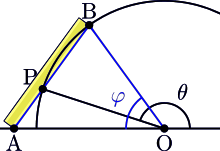Neusis construction
The neusis is a geometric construction method that was used in antiquity by Greek mathematicians.

Geometric construction
The neusis construction (from Greek νεῦσις from νεύειν neuein "incline towards"; plural: νεύσεις neuseis) consists of fitting a line element of given length (a) in between two given lines (l and m), in such a way that the line element, or its extension, passes through a given point P. That is, one end of the line element has to lie on l, the other end on m, while the line element is "inclined" towards P.
A neusis construction might be performed by means of a 'neusis ruler': a marked ruler that is rotatable around the point P (this may be done by putting a pin into the point P and then pressing the ruler against the pin). In the figure one end of the ruler is marked with a yellow eye with crosshairs: this is the origin of the scale division on the ruler. A second marking on the ruler (the blue eye) indicates the distance a from the origin. The yellow eye is moved along line l, until the blue eye coincides with line m. The position of the line element thus found is shown in the figure as a dark blue bar.
Point P is called the pole of the neusis, line l the directrix, or guiding line, and line m the catch line. Length a is called the diastema (διάστημα; Greek for "distance").

Use of the neusis
Neuseis have been important because they sometimes provide a means to solve geometric problems that are not solvable by means of compass and straightedge alone. Examples are the trisection of any angle in three equal parts, the doubling of the cube, and the construction of a regular heptagon, nonagon, or tridecagon (polygons with 7, 9, or 13 sides).[1] Mathematicians such as Archimedes of Syracuse (287–212 BC) and Pappus of Alexandria (290-350 AD) freely used neuseis; Sir Isaac Newton (1642-1726) followed their line of thought, and also used neusis constructions.[2] Nevertheless, gradually the technique dropped out of use.
A regular n-gon is known to be constructible with the neusis for n =
- 3, 4, 5, 6, 7, 8, 9, 10, 11, 12, 13, 14, 15, 16, 17, 18, 19, 20, 21, 22, 24, 26, 27, 28, 30, 32, 33, 34, 35, 36, 37, 38, 39, 40, 42, 44, 45, 48, 51, 52, 54, 55, 56, 57, 60, 63, 64, 65, 66, 68, 70, 72, 73, 74, 76, 77, 78, 80, 81, 84, 85, 88, 90, 91, 95, 96, 97, 99, 102, 104, 105, 108, 109, 110, 111, 112, 114, 117, 119, 120, 126, 128, ... (sequence A122254 in the OEIS), modified by the recent finding by Benjamin and Snyder that the regular hendecagon is neusis-constructible,[3]
while a regular n-gon is known to be non-constructible with the neusis for n =
- 23, 29, 43, 46, 47, 49, 53, 58, 59, 67, 69, 71, 79, 83, 86, 87, 89, 92, 94, 98, 103, 106, 107, 113, 115, 116, 118, 121, 127, ... (sequence A048136 in the OEIS), similarly modified.
with the status still an open question for n =
- 25, 31, 41, 50, 61, 62, 75, 82, 93, 100, 101, 122, 123, 124, 125, ...
Waning popularity
T. L. Heath, the historian of mathematics, has suggested that the Greek mathematician Oenopides (ca. 440 BC) was the first to put compass-and-straightedge constructions above neuseis. The principle to avoid neuseis whenever possible may have been spread by Hippocrates of Chios (ca. 430 BC), who originated from the same island as Oenopides, and who was—as far as we know—the first to write a systematically ordered geometry textbook. One hundred years after him Euclid too shunned neuseis in his very influential textbook, The Elements.
The next attack on the neusis came when, from the fourth century BC, Plato's idealism gained ground. Under its influence a hierarchy of three classes of geometrical constructions was developed. Descending from the "abstract and noble" to the "mechanical and earthly", the three classes were:
- constructions with straight lines and circles only (compass and straightedge);
- constructions that in addition to this use conic sections (ellipses, parabolas, hyperbolas);
- constructions that needed yet other means of construction, for example neuseis.
In the end the use of neusis was deemed acceptable only when the two other, higher categories of constructions did not offer a solution. Neusis became a kind of last resort that was invoked only when all other, more respectable, methods had failed. Using neusis where other construction methods might have been used was branded by the late Greek mathematician Pappus of Alexandria (ca. 325 AD) as "a not inconsiderable error".
References
- Weisstein, Eric W. "Neusis Construction." From MathWorld--A Wolfram Web Resource. http://mathworld.wolfram.com/NeusisConstruction.html
- Guicciardini, Niccolò (2009). Isaac Newton on Mathematical Certainty and Method, Issue 4. M.I.T Press. p. 68. ISBN 9780262013178.
- BENJAMIN, ELLIOT; SNYDER, C. Mathematical Proceedings of the Cambridge Philosophical Society156.3 (May 2014): 409-424.; https://dx.doi.org/10.1017/S0305004113000753
- R. Boeker, 'Neusis', in: Paulys Realencyclopädie der Classischen Altertumswissenschaft, G. Wissowa red. (1894–), Supplement 9 (1962) 415–461.–In German. The most comprehensive survey; however, the author sometimes has rather curious opinions.
- T. L. Heath, A history of Greek Mathematics (2 volumes; Oxford 1921).
- H. G. Zeuthen, Die Lehre von den Kegelschnitten im Altertum [= The Theory of Conic Sections in Antiquity] (Copenhagen 1886; reprinted Hildesheim 1966).